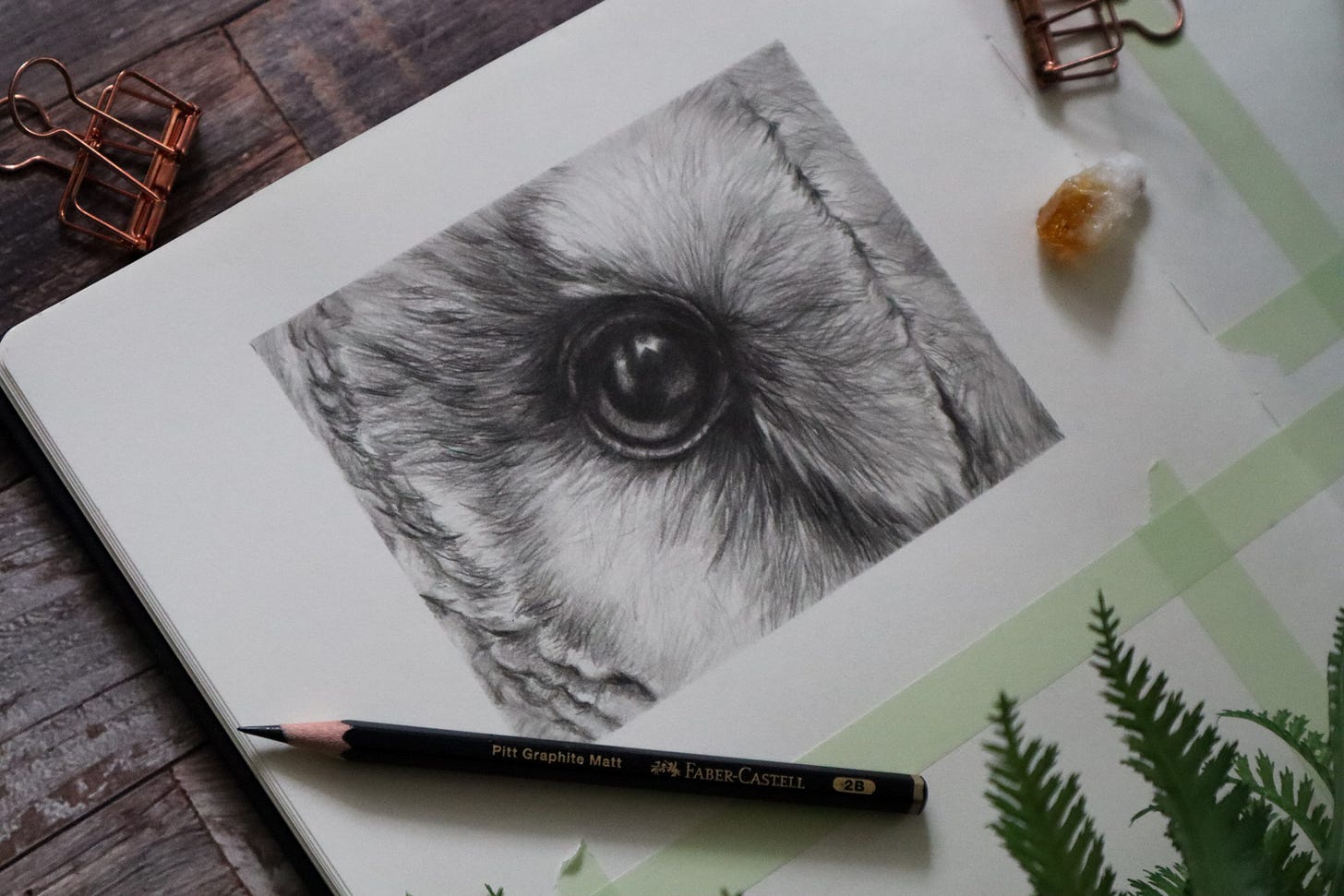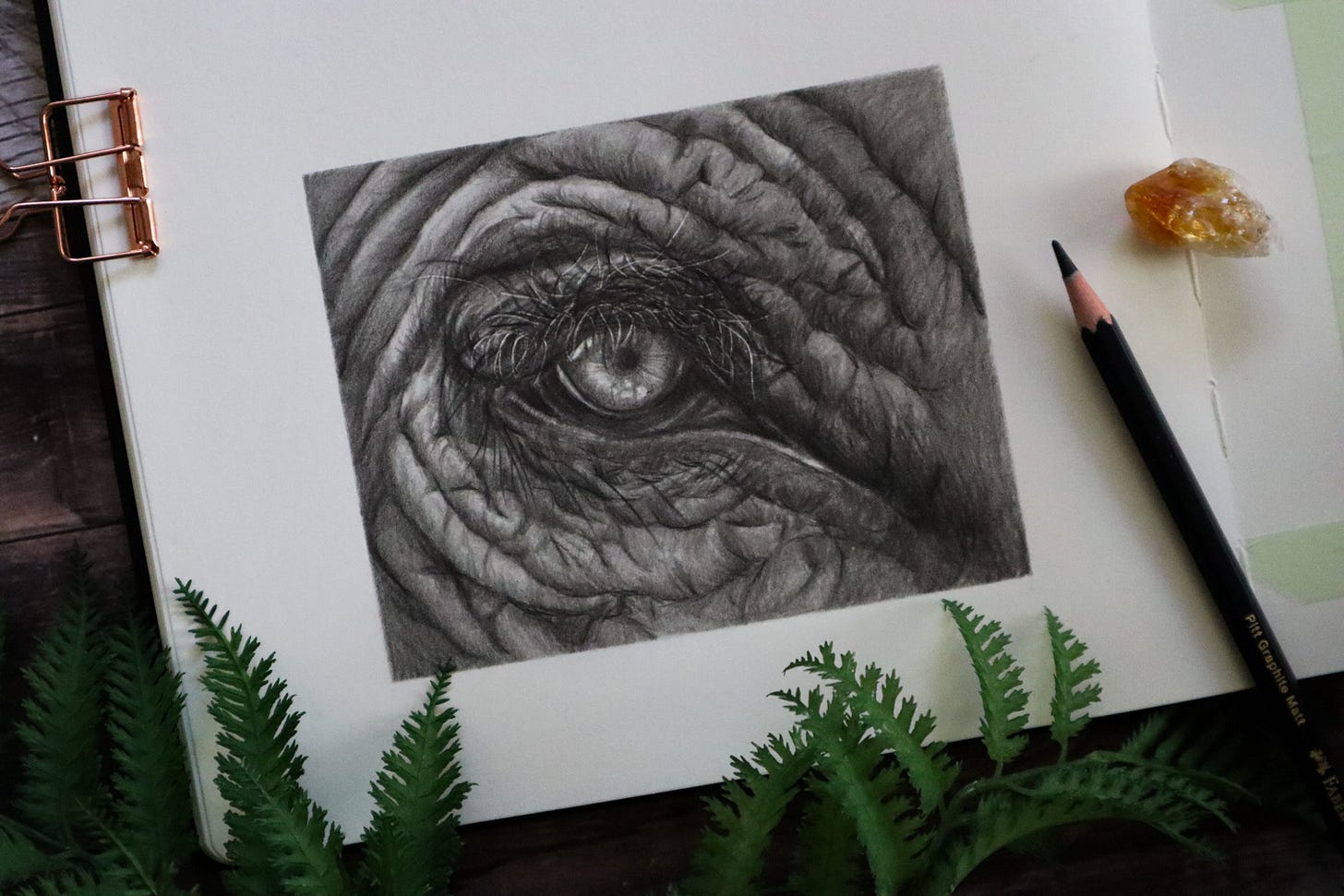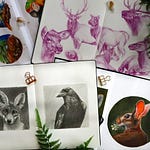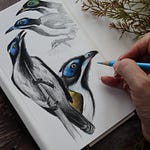We’re going to get a little deep today. A little philosophical even.
Stick with me, I really want to know your thoughts about all this, whether you have considered the same, or what perspective you carry. That is the most valuable part of having a community like this, I think, getting to learn from each other, getting to listen to different experiences and thoughts that let us think, and experience, a little more ourselves too.
Ok. Ready?
We are going to talk about seeing, really seeing, our wildlife subjects, and what that does for us as artists, and as human animals.
As human beings, we are naturally primed to look for faces, to look for eyes - it is how we find safety when we are too small to care for ourselves, and as we are older, it is how we find faces in mundane objects, like the front of a car or electric plug sockets (or wooden floors or toast! This is called pareidolia.).
We are primed to make eye to eye contact.
We are primed to see deeply into another being’s eyes and assess for kindness or danger.
We are primed to connect by really seeing.
When I create my wildlife portraits, the place I spend the most time, and the aspect that gives me profound joy, is in rendering the face of my subject. Specifically the eyes. This is how we connect, how we feel that little race of the heart at the power and danger and intense intrigue of a wolf. How we imagine flying silently over grasses and treetops with the elegance and grace of an owl. How we embody the gentle strength and innate wisdom of an elephant as we paint or draw them. That makes us smile or get curious or lets our wild hearts feel a little more, well, untamed. And those representations of eye are what connects most deeply with viewers of our art too (even when that viewer is yourself alone)
I talk to my drawings, to my sketches, to my paintings, and I encourage all artists who draw wildlife to do the same.
As we talk to our wild friends we open dialogue with the oldest parts of ourselves even as we are also embodying our subject - literally taking them into our body through our eyes, through our sense of sight. But that conversation begins in earnest when I have some eyes to look at - even when they are not directly facing me.
The painting or drawing starts to inhabit the beingness that I see in the reference.
I see an individual, a distinct person who has their own likes and dislikes, their own feelings and experiences, their own intelligence and curiosity. My rendering will not be exactly the same as the beautiful reference photo, but a representation, an honouring, all of its own, inspired by the very real being that I am deeply observing.
In fact, what my drawing, my painting, my sketch is, is me.
It is the being I studied come through my senses and out of my pencil or paintbrush through the flesh and blood of my hand moving, and onto the surface. How could it be anything but me?
It is me, the barn owl.
It is me, the wolf.
It is me, the elephant.
It is my experience of the reverence and honour that I hold for the incredible being behind the reference, but it always comes through a filter of me. My art will never be exactly her, because she is her own being, she is often on the other side of the world to me, and living in an experience of time and space that I can only barely grasp the edges of in my imagination. But I can honour and celebrate and respect and revere her through my hands and heart, and together we get to become something altogether new, but which holds a tiny part of the sacredness of us both.
Because it is me there, in lion and tiger and bear (oh my), the time I spend on rendering the eyes is time that I am looking through an infinite iteration of eyes looking into eyes. Me to her, her through me, me through her, our genetic memories entwining over aeons, to the point of recognition when we were the same stardust.
I shake a little as I type this because it is powerful and all encompassing, and more than a little magical.
And it might sound a tiny bit odd if you have not considered art this way.
Our reality is the experiences we have through the filter of us, and in art, we are embodying what we are seeing, what we are studying, and we are translating that for others to view (or for yourself to view later) through pigment and passion. In that translation is all our wonder and adoration, our fears and frustration, our curiosity and courage.
For me, this practice of art making, the gentle and dedicated meditative flow of creating, is a way for me to hold deep observation, deep connection, deep compassion for the wild world as a whole, and for that tiny bit of wild, that tiny bit of untamed, that still lives in my heart,
even in a modern world.
As I move further along this art-path, I have come to understand that the sort of art we are drawn to making is probably the medicine we need most - the energy in us that needs expressing and to be seen most. Landscapes, florals, figurative, abstract - all such beautiful energy that attracts the right curious creative to express the unique energy they offer.
It does not surprise me now that for me that energy, that medicine, is in wild beings. I can’t imagine a time when it won’t be, because I can’t imagine ever learning enough to feel even remotely done. I connect with that medicine, with that energy, in the way that we are primed to, through eyes. It is where I spend the most time on my paintings and drawings, and it is where I find the most intense connection and profound wonder. So translating that through pigment is then my connection through a filter of me to the stark awe that I get to be alive on this tiny pale blue dot in a universe of swirling beingness. And that I get to share this moment with a wholly different wild being who I can only dream of becoming ever deeper in conversation with.
Looking into the eyes of more-than-human beings (including the tiny wild-hearted beings that are part of our individual fur and feather families) is when I feel most seen. It is when I feel most seen. Where there is simple recognition and understanding, where there is love and compassion, where there is wariness and interest, and so much more. But there is a level of authenticity and openness in those encounters that, for me, cannot be truly replicated in human-to-human connection.
And so, in a world where humans (as a collective) seem to do everything they can to hurt and harm each other and the planet we live on, it is my work to remember the wild within and without.
To sing their wild song through pigment.
To make connections with, to revere, to delight, to express the beauty and wisdom and profundity of our wild kin, and share it with you, through a filter of me.
And hope that I get to see your experience of seeing and being seen, through a filter of you, in whatever way you use to express your creativity.
I see you, wild one. I see the wild in us. And I see the wild.
The third chapter in my wildlife art course collection is here. See the Wild focuses on understanding how to realistically represent the spark of life we make deep connections with in our wildlife drawings - their eyes. Through seventeen different projects that range from half hour to two hour studies, we get to embody seventeen wild beings, and start to understand their unique beauty and how we can portray that with reverence and curiosity and honour. Interested? You can find out more by clicking below:





















Share this post